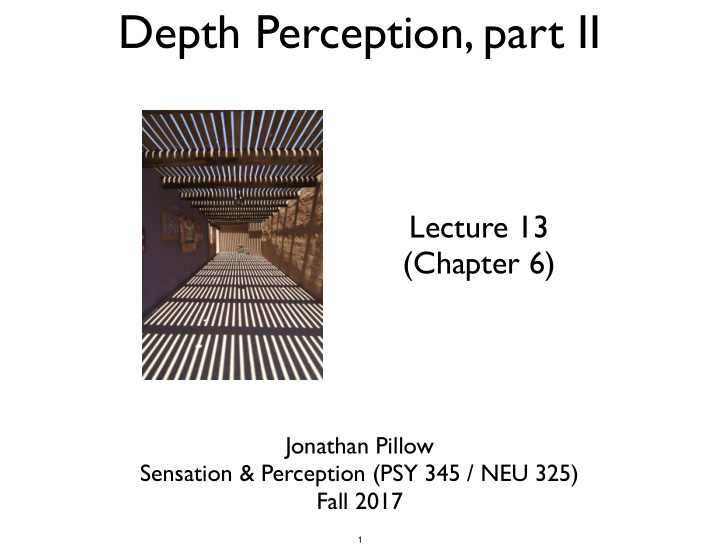



Depth Perception, part II Lecture 13 (Chapter 6) Jonathan Pillow Sensation & Perception (PSY 345 / NEU 325) Fall 2017 1
nice illusions video - car ad (2013) (anamorphosis, linear perspective, accidental viewpoints, shadows, depth/size illusions) https://www.youtube.com/watch?v=dNC0X76-QRI 2
Accommodation - “depth from focus” near far 3
Depth and scale estimation from accommodation “tilt shift photography” 4
Depth and scale estimation from accommodation “tilt shift photography” 5
Depth and scale estimation from accommodation “tilt shift photography” 6
Depth and scale estimation from accommodation “tilt shift photography” 7
Depth and scale estimation from accommodation “tilt shift photography” 8
more on tilt shift: Van Gogh http://www.mymodernmet.com/profiles/blogs/van-goghs-paintings-get 9
Tilt shift on Van Gogh paintings http://www.mymodernmet.com/profiles/blogs/van-goghs-paintings-get 10
11
12
countering the depth-from-focus cue 13
Monocular depth cues: Pictorial Non-Pictorial • occlusion • motion parallax • relative size • accommodation • shadow (“depth from focus”) • texture gradient • height in plane • linear perspective 14
• Binocular depth cue: A depth cue that relies on information from both eyes 15
Two Retinas Capture Different images 16
Finger-Sausage Illusion: 17
Pen Test: Hold a pen out at half arm’s length With the other hand, see how rapidly you can place the cap on the pen. First using two eyes, then with one eye closed 18
Binocular depth cues: 1. Vergence angle - angle between the eyes convergence divergence If you know the angles, you can deduce the distance 19
Binocular depth cues: 2. Binocular Disparity - difference between two retinal images Stereopsis - depth perception that results from binocular disparity information (This is what they’re offering in 3D movies…) 20
21
Retinal images in left & right eyes Figuring out the depth from these two images is a challenging computational problem. (Can you reason it out?) 22
Disparity : difference between points in L and R eye images 23
Horopter : circle of points that fall at zero disparity (i.e., they land on corresponding parts of the two retinas) A bit of geometric reasoning will convince you that this surface is a circle containing the fixation point and the two eyes 24
25
point with uncrossed disparity point with crossed disparity appears closer appears further 26
Is this a simple picture or a complicated computational problem? 27
Interpreting the visual information from three circles This one requires an accidental viewpoint Known as the “ correspondence problem ” - which points in the left eye go with which points in the right eye? 28
Wheatstone’s stereoscope • device for presenting one different images to the two eyes 29
Free fusing - focusing the eyes either nearer or farther than this image so that each eye sees a different image 30
Free fusing - focusing the eyes either nearer or farther than this image so that each eye sees a different image “Crossed-fusion” L retina R retina 31
Free fusing - focusing the eyes either nearer or farther than this image so that each eye sees a different image “uncrossed fusion” L retina R retina 32
Random Dot Stereogram - same concept, but no detectable “features” in either image. Details of dot pattern allow brain to solve the correspondence problem 33
“Magic Eye” images use same principle 34
If you were designing a visual system, how might you go about designing neurons tuned for different disparity? 35
The brain solves this problem with disparity-tuned neurons 36
Binocular Vision and Stereopsis How is stereopsis implemented in the human brain? • Input from two eyes must converge onto the same cell • Many neurons: respond best when the same image falls on corresponding points in the two retinas (this is the neural basis for the horopter) • However: many neurons respond best when similar images occupy slightly different positions on the two retinas • i.e., these neurons are “ tuned to a particular disparity ” 37
Panum’s fusional area : only certain range of disparities that the brain can fuse - comes from distribution of disparity-tuned neurons Panum’s fusional area 38
Recommend
More recommend